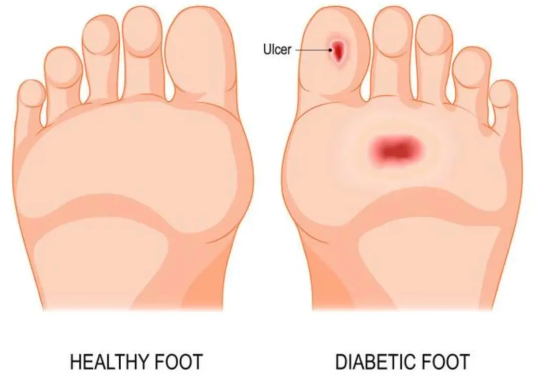Caring for diabetic foot ulcers requires scientific methods and patient perseverance. Many diabetics tend to ignore wounds on their feet, unaware that high blood sugar levels are quietly impairing the body's ability to repair them. If improperly treated, these wounds can develop into serious infections and even lead to amputation.

How to take care of it in daily life?
Patients with diabetic foot often experience some special symptoms and need to pay special attention to daily care. When numbness or tingling occurs in the extremities, observe the skin color and temperature changes of the extremities every day, check for ulcers, feel the pulse of the dorsalis pedis artery, and record the time, nature, and degree of pain. If you feel loss of extremities or a crawling sensation, if the skin is not broken, you can soak your feet in warm water of about 38°C every day. After soaking, gently dry them with a soft, absorbent towel, paying special attention to thoroughly dry the water marks between the toes. You can usually massage acupoints such as Zusanli, Diji, and Taixi to promote blood circulation. Be especially careful when heating in winter, and avoid direct contact between hot water bottles and electric heaters to prevent burns and infections.
What kind of dressing is suitable for this type of wound?
Silver foam dressings are currently an ideal treatment option. They contain silver ions, which effectively kill bacteria. Their foam structure absorbs large amounts of exudate, keeping the wound moderately moist. Important points to keep in mind when using them: First, thoroughly rinse the wound with saline solution; avoid irritating the wound with alcohol or iodine. Measure the wound and cut the dressing slightly larger than the wound. For deep wounds, fill the wound loosely, not too tightly. Secure with gauze or a bandage, generally changing it every 3-4 days.
Traditional Chinese Medicine in the care of diabetic foot :
Patients with early-stage diabetic foot (stage 0) can try traditional Chinese medicine foot baths, but those with skin ulcers (stage 1 and above) cannot. According to Traditional Chinese Medicine (TCM) syndrome differentiation, diabetic foot is divided into three main types: Qi and Yin deficiency, damp-heat obstruction, and spleen and kidney yang deficiency, with Qi and Yin deficiency being the most common. Patients with Qi and Yin deficiency can soak their feet in water boiled with herbs such as cinnamon twig, astragalus root, and ginger. If numbness and tingling occur in the feet, herbs such as peach kernel, licorice root, and Chuanxiong root can be used. To achieve this, add the herbs to water, bring to a boil, then simmer for 15-20 minutes. After filtering, wait until the water cools to around 38°C before soaking for 15-20 minutes. A 15-day treatment course is considered. Maintaining a constant water temperature is recommended; a constant-temperature foot bath tub is recommended.
What should we pay attention to in daily care?
For infected areas, maintain a light diet, quit smoking, and limit alcohol consumption. Patients with severe infections are advised to rest in bed and minimize activity to avoid exacerbating the infection. However, some movement in bed is recommended to promote blood circulation. Maintain a comfortable room temperature, clean and dry bedsheets, and pay special attention to the cleanliness and care of the infected area. If the foot is already broken, avoid soaking the foot to prevent the infection from spreading.
For patients who suffer from avascular necrosis of the extremities or even require amputation, it is important to maintain good ventilation in the room. A light diet is recommended. Avoid eating irritating foods such as beef, mutton, and seafood for the time being, but you can increase your protein intake appropriately to help wound healing. Functional exercises should be strengthened. If you notice redness, tenderness, or ulceration on the residual limb, seek medical attention promptly. Keep the residual limb warm in winter and keep the wound dressing dry. If pus is discharged after incision, closely observe the color, nature, and amount of the pus. Take antibiotics as directed by the doctor if necessary. Maintain joint function and prevent joint contractures.
Strict blood sugar control is fundamental. Take medication on time and monitor blood sugar levels regularly. Ensure nutritional intake and eat more protein-rich foods, such as eggs, fish, and lean meat, to help wound repair. Reduce pressure on the wound by customizing special pressure-relieving insoles to prevent further friction on the wound area. Check your feet every day, especially the soles of the feet and between the toes, which are easily overlooked. If you notice that the wound is black, pus is oozing, or has a bad odor, or if you have a fever or chills, seek medical attention immediately. These may be signs of a serious infection and require professional treatment. Prevention is always better than a cure. People with diabetes should develop the habit of checking their feet every day. When washing their feet, the water temperature should not exceed 37 degrees Celsius, and they should be thoroughly dried after washing. Choose soft, breathable shoes and socks, and take time to get used to new shoes. Go to a specialist hospital for regular foot examinations and deal with any problems promptly.
Caring for diabetic foot ulcers is a systematic process that requires the joint efforts of patients, their families, and their physicians. Silver foam dressings are a helpful aid, but the most critical aspects are maintaining blood sugar control and taking daily precautions. With proper care and consistent treatment, most wounds heal well. For more information on Innomed® Silver Ion Dressing Foam, refer to the Previous Articles. If you have customized needs, please contact us; we wholeheartedly. At Longterm Medical, we transform this data by innovating and developing products that make life easier for those who need loving care.
Editor: kiki Jia

 English
English عربى
عربى Español
Español русский
русский 中文简体
中文简体








